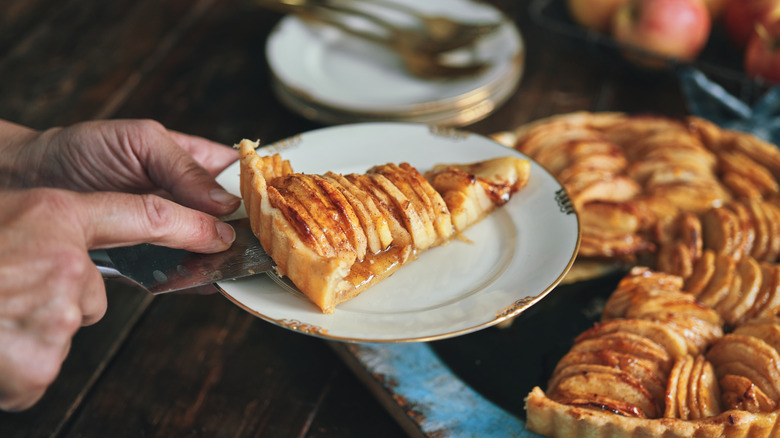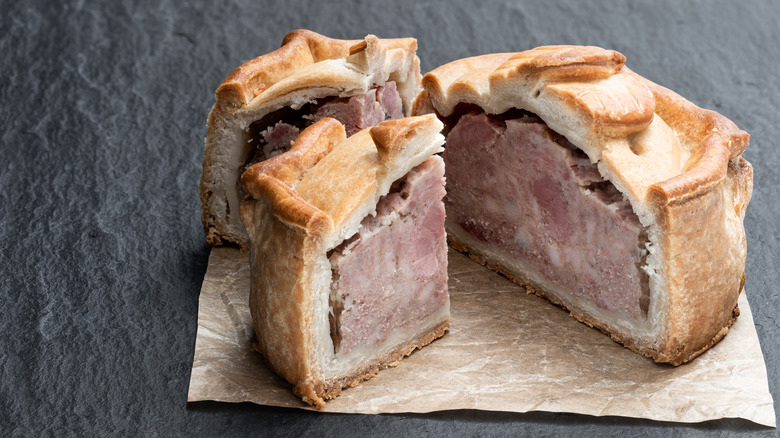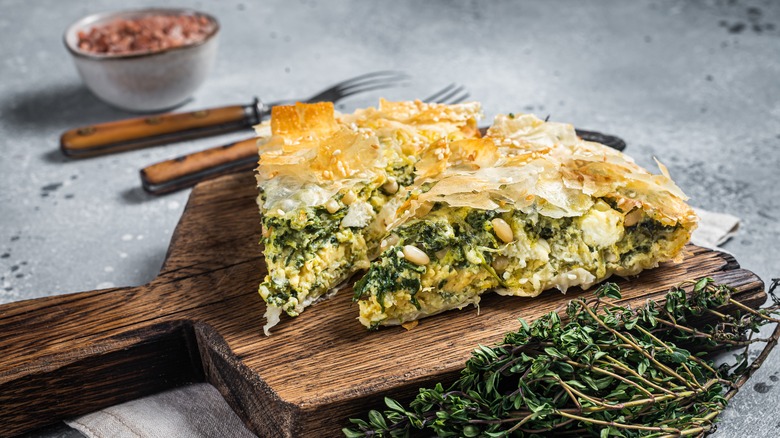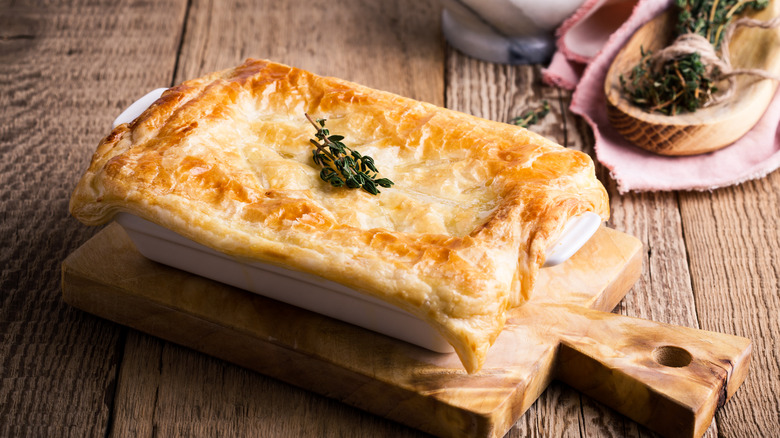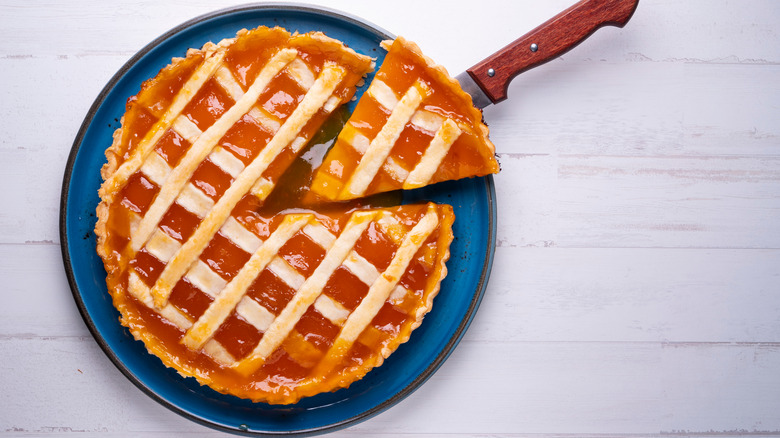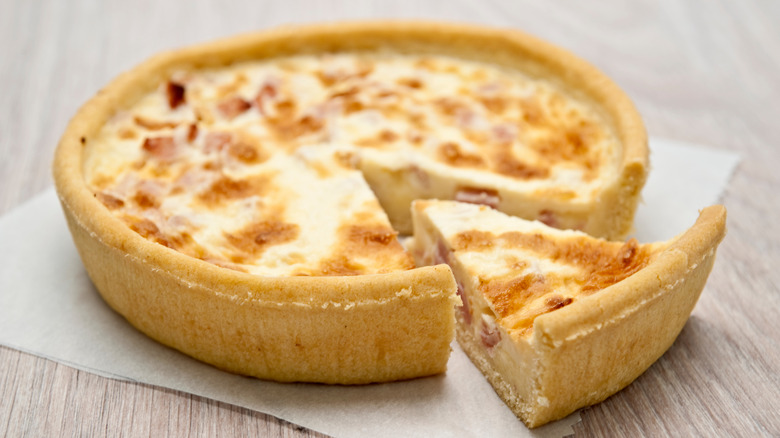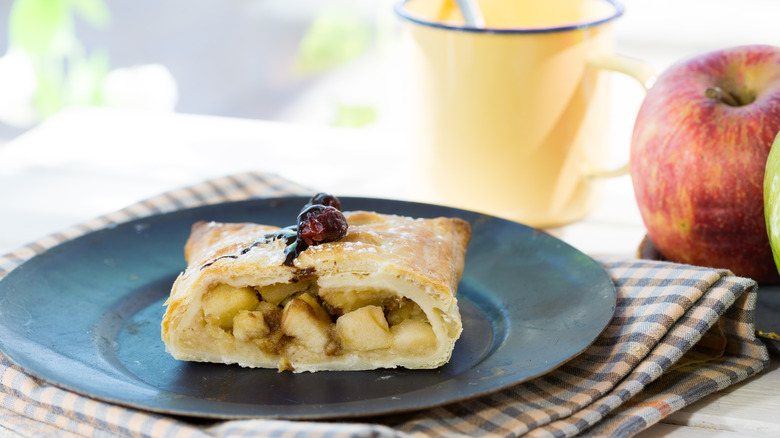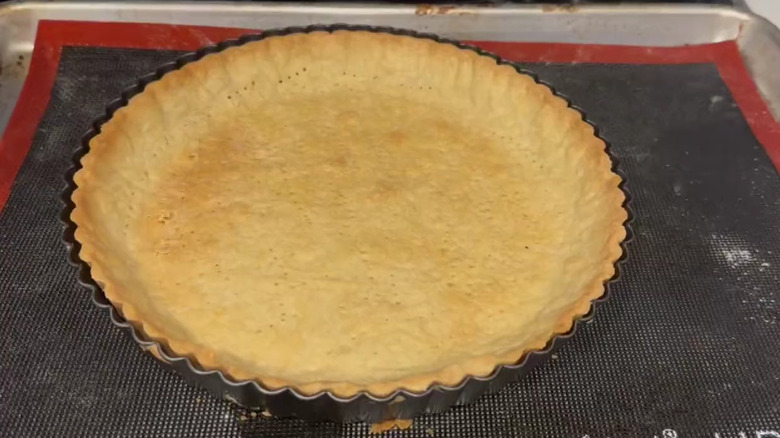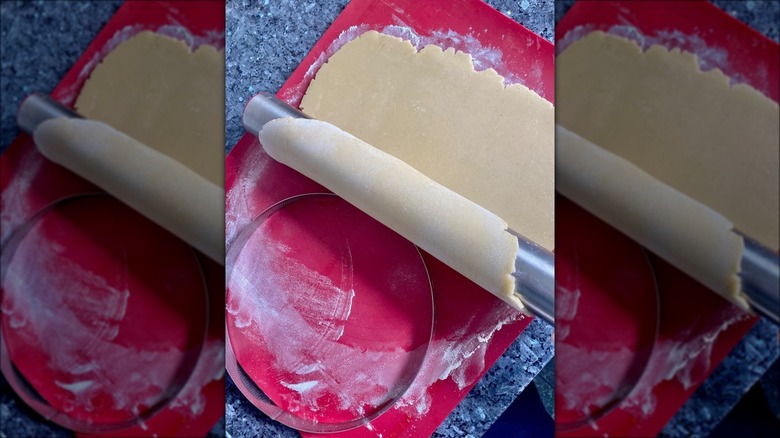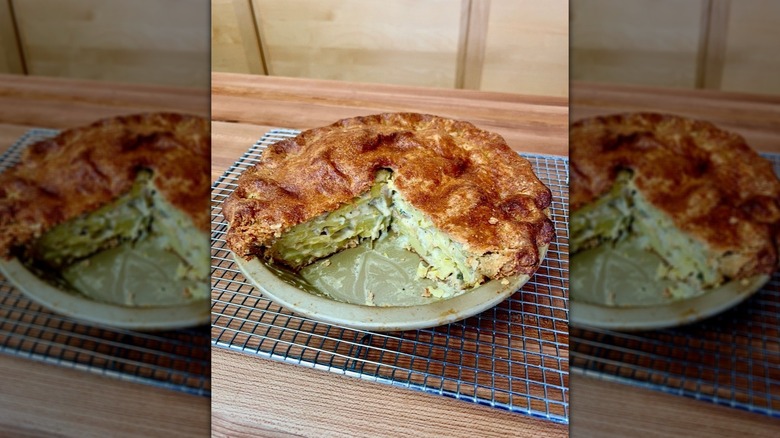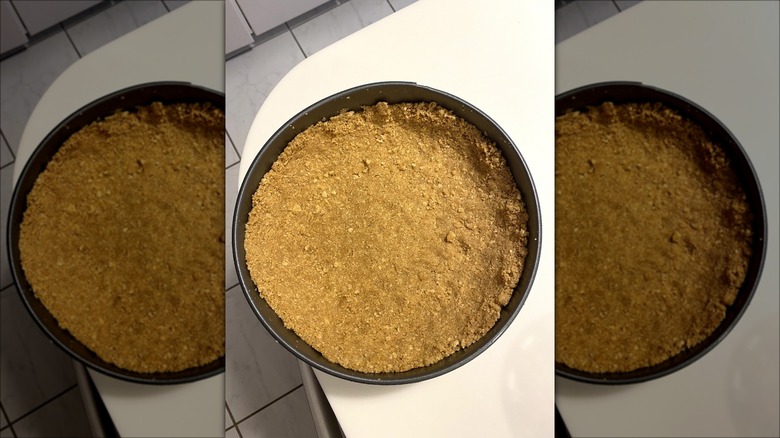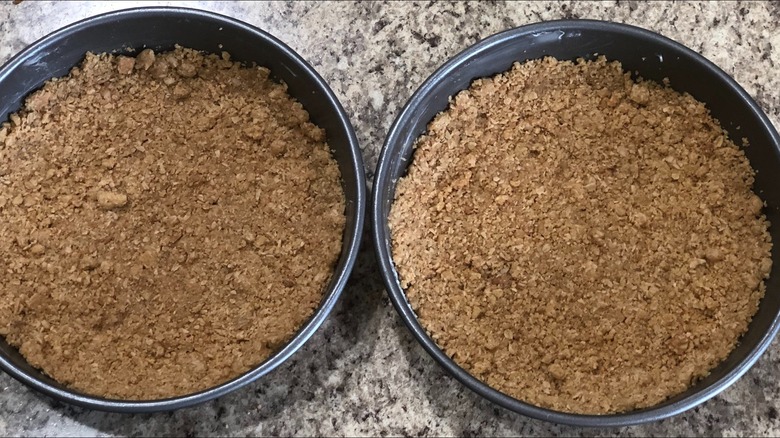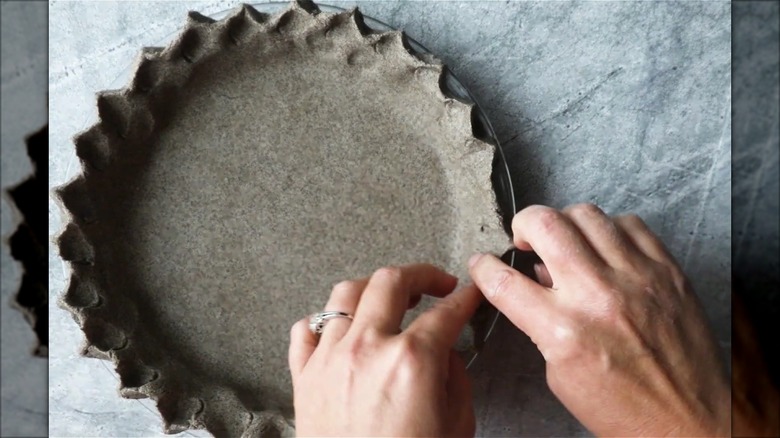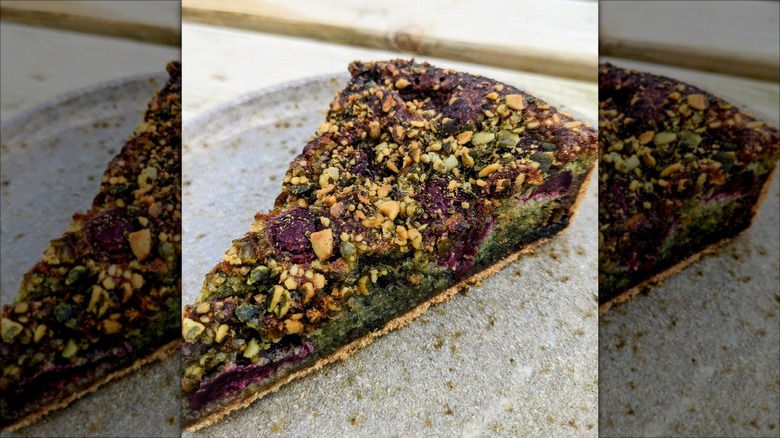13 Types Of Pie Crusts And The Best Fillings For Them
The practice of encasing food in dough and baking most likely has its origins in the ancient civilizations of Greece and Egypt. Over millennia, pie-making spread across the world and took on a myriad of forms. As a result, the diners of today have more choices than ever before when it comes to the different types of pie crust and filling.
Many Americans are becoming less familiar with pie crusts; according to surveys performed by Statista, around 56.5 million Americans used either frozen or ready-made pie shells in 2020 alone. By outsourcing the work, Americans are losing their understanding of doughs, thus making pairing crust with a complementary filling an increasingly challenging task.
As we dive headfirst into pie season, the ability to match a crust with a suitable filling is more important than ever. With that in mind, we have gathered information on 13 prevalent pie crusts and the fillings that are best suited to them from baking companies and professional bakers.
1. Hot water crust: Pork
Hot water crust pastry was most likely invented in the United Kingdom and was designed as a means to contain juicy, meat-rich fillings without crumbling or leaking. The pastry is uniquely suited to this task as it is remarkably strong once baked.
Hot water pastry is made by mixing boiling water with a form of melted fat. This wet mixture is then added to the flour and salt to create the dough. Hot water is used as it enables the flour to absorb more liquid. This high moisture content is what gives the pastry its strength. As an added bonus, hot water makes the raw dough extremely pliable, allowing bakers to shape pies with ease.
Although it has many advantages, hot water pastry is quite tough making it only suited to hearty, robust fillings. The most well-known of these is pork. Pork pies made with hot water pastry are a beloved part of British cuisine and readily demonstrate all the advantages of hot water pastry. Other applications of the pastry include encasing traditional British bakes like Scottish bridies and Cornish pasties.
2. Filo crust: Wilted greens, sweetened nuts
Popular in the Middle East and Mediterranean, filo pastry is made from an unleavened dough of wheat flour, oil, water, and salt. The pastry is sold pre-made in thin sheets. Usually, these sheets are layered upon each other to form a pie crust. Care must be taken when handling as the sheets are very thin, delicate, and prone to tearing.
As the filo sheets crisp up when baked, the multiple layers of pastry create a brilliant, flaky texture that shatters in the mouth. This makes filo crusts ideal for lighter fillings. An example of this is spanakopita, a Greek pie that sees an abundance of wilted greens and feta placed within a filo crust.
Due to its neutral taste, filo pastry can also be used for sweet dishes. Traditionally, it is used to make baklava, a pastry made of filo, chopped nuts and syrup. A simpler take on this sweet is the baklava pie. This is made by building a filo pastry base and filling it with the sweetened nut mix. Although this dish breaks from the layered nature of true baklava, it still boasts the same instantly recognizable flavor profile.
As a happy aside, filo pastry has a significantly lower fat content than other types of pastry. It contains far less fat than puff pastry, making it a healthy substitute for those looking to cut down their dietary fat intake without giving up pies altogether.
3. Puff pastry crust: Just about anything
Although similar, puff pastry is distinct from flaky crust. Unlike flaky crust, the only fat used in puff pastry comes from the inclusion of butter. This butter is layered between the dough in a painstaking rolling and folding process. When it cooks, the layering results in the formation of many flaky layers during baking as the butter and water convert to steam.
The puff pastry was invented in 1645 and has become an integral part of many pies, both savory and sweet, over the intervening centuries. Largely, this is attributable to the combination of puff pastry's crisp texture and high fat content which imparts a luxurious feel to any filling.
As puff pastry is so time-consuming to make, most people buy pre-packaged pastry from the store. While convenient, buying pre-packaged puff pastry can lead people to overlook the unhealthy aspects of the pastry. Diners must remain aware that puff pastry is very high in fat, trans fats, and incredibly saturated.
4. Crostata crust: Fruit, jam
Crostatas are simple Italian pies that are usually filled with jam. The pastry used to create the crostata — otherwise known as pasta frolla — is noticeably sweet. Most pasta frolla recipes call for butter, flour, sugar, and eggs. Bakers can also get inventive by adding a few additional flavorings like citrus zest, liquors, or spices. When cooked, the pastry should be short and crumble when eaten.
As with most Italian foods, crostatas are defined by their seasonality and simplicity. Fillings reflect this, with fruits and jams being used during summer and early autumn, while root vegetables are often incorporated during the winter. Regardless of what fruit or vegetable is used, the pie is nearly always sweet, as savory fillings do not pair well with this style of crust. Care should also be taken to ensure that any flavorings used in the crust complement the ingredients used in the filling lest an unappetizing clash take place.
5. Shortcrust pastry: Cheese, vegetables
Shortcrust pastry creates a simple, versatile pie crust that is well-suited to a number of fillings. This style of crust is renowned for its crumbly texture, which results from the gluten being inhibited from developing. Bakers achieve this by rubbing the fat — often a mixture of butter and lard — into the flour, keeping the pastry cool, and only working the dough lightly.
While crumbly when eaten, the cooked crust is also fairly robust, allowing it to stand up to hearty, wet fillings. As a result, shortcrust pastry is often used for savory pies like quiche. In this dish, an array of ingredients, including cheese, fish, meat, and vegetables, can feature alongside an egg and cream filling. When combined with a shortcrust pastry crust, the result is a texturally engaging pie that boasts an impressive amount of flavor.
In a pinch, regular shortcrust pastry can also be used alongside a number of sweet fillings. However, we believe that other, distinct forms of shortcrust pastry are better suited to accompany these.
6. Flaky crust: Fruit
Flaky crust, also known as rough puff, is made in much the same way as puff pastry. The only difference is that a combination of lard and butter is used in the dough instead of butter alone. The inclusion of lard results in a pastry that is even flakier than regular puff pastry. However, as lard is much less flavorful than butter, the finished pastry tastes more bland.
Making flaky pastry involves fewer folds and a less-even application of fat between layers. Although this means a flaky crust is much easier to make, it does mean that it rises less during cooking. As a result, some pies will not appear as impressive as they would when made with regular puff pastry.
Flaky crust's biggest draw is its texture. The best way to utilize this strength is to pair it with fillings that are soft. Stewed fruit or jam is a fantastic option, as the crisp crust stands in direct contrast with the soft, sweet filling. What's more, the strong flavors of fillings like stewed fruits make up for the crust's diminished flavor.
7. Pâte sablée: Lemon, fruit
Pâte sablée is a French shortcrust pastry that is most often used for pastry tarts. The reason why this crust is so suited to pastry tarts is its texture; pâte sablée is known for being incredibly fine and short, thanks to the inclusion of both butter and egg yolks. To make the crust even finer, bakers often substitute some of the flour for ground almonds.
These crusts are best paired with similarly refined fillings, including artistically layered pieces of softened fruit and heapings of crème pâtissière. Another great filling for pâte sablée pie crusts is lemon curd, as the silky texture of the curd directly contrasts with the fine crust. This dish is known as tarte au citron.
Such a delicate crust demands a similarly delicate filling. As such, heavy, robust fillings are not advisable. We also find that the fine texture of the crust requires a relatively smooth filling; large chunks of any ingredient, unless well softened, can prove particularly jarring. Finally, pâte sablée crusts are best enjoyed the day they are baked. If left too long, the crust loses its fine texture and a huge part of the pie's appeal.
8. Pâte sucrée: Crème pâtissière, chocolate ganache
Pâte sucrée is another type of French shortcrust pastry. What makes pâte sucrée distinct is the higher proportion of sugar that's used in the dough. This sugar not only sweetens the crust but gives it a texture that's crisper than pâte sablée, making it well-suited to use with creamy, wet fillings.
The dough can be blind-baked until it is done. This allows it to be paired with unbaked fillings like crème pâtissière and chocolate ganache. The crust is also routinely paired with other sweet fillings, including stewed fruits and jams.
Pâte sucrée is one of the most flavorful pie crusts on this list, as was highlighted by baker Edd Kimber in an interview with Khoollect: "It has just the right level of sweetness, a great texture and tastes fantastic. Even baked into simple rounds and served as a biscuit it would taste great." While this flavor transforms many sweet pies into excellent dishes, it also means that pâte sucrée should never be used alongside savory ingredients; the resulting pie would be far too jarring.
9. Whole wheat crust: Vegetables, cheese
Nutritionally speaking, all-purpose flour is less nutritious than whole wheat flour for reasons Mary Ellen Camire, a professor of food science and human nutrition, explained to the American Heart Association: "White or all-purpose flour is less nutritious because, in the milling process, they take off the outer bran, which contains most of the dietary fiber, and the germ, which is the heart of the seed." Consequently, many health conscious people prefer to use whole wheat flour in their crust.
A straight swap is not advisable as it can detrimentally affect the crust's texture. Instead, a combination of all-purpose flour and whole wheat is used to create a healthier but no less effective pie crust.
It's not just good nutrition that whole wheat crusts offer but flavor, too. These crusts are noted for having a deeply nutty taste, which naturally pairs with a host of vegetables, including beetroot, butternut squash, and red onion. What's more, the flavor of whole grain pie crusts provides a nice counterpoint to rich ingredients, including cheese. While whole wheat crusts can be used alongside sweet fillings, we would advise using other pastry crusts featured on this list.
10. Graham cracker crust: Lime, cream, chocolate
As the name suggests, a graham cracker crust is a pie crust made from blitzed graham crackers. The ground crackers are combined with butter, sugar, and spices before being pressed into a pie tin. This crust does not require baking but benefits from chilling in the fridge. For this reason, graham cracker crusts are most suited to non-bake pie fillings like cream cheese, crème pâtissière, and jam. That being said, the crust can be baked for short periods to make dishes, including key lime pie.
The graham cracker crust is the easiest to make of the crusts on our list. This makes it a fantastic choice for parents wanting to bake with their children or anybody who's pressed for time. Another advantage of the graham cracker crust is that it can easily be made gluten-free. All bakers have to do is swap out regular graham crackers for gluten-free versions of the product.
11. Oatmeal crust: Cream
Oatmeal makes for another excellent gluten-free pie crust and is made in a similar way to the graham cracker crust. The main difference in preparation is that oatmeal crusts must be baked until golden brown. The crust is not suited to long bake times, however, as it will burn quite easily. As a result, fillings that need a long cooking time are not recommended.
After baking is complete, the crust takes on a chewy yet crisp texture, much like an oatmeal cookie. This, and its neutral flavor, means that many flavors compliment the crust, especially warming spices such as cinnamon. For this reason, the crust is well-suited to fillings that are popular in fall, like apple and cinnamon. Equally, oatmeal pie crusts can be filled with non-bake fillings. Perhaps the easiest and most effective of these is a mixture of bananas and cream.
From a health perspective, oatmeal crusts offer a variety of benefits, including a high fiber content. This makes it a healthier choice than most other pie crusts on this list, as implied by the Mayo Clinic.
12. Buckwheat crust: Caramel, cheese
Buckwheat is a pseudo-grain that can be milled into a distinctly savory and slightly bitter flour. Despite this, the flour is a good accompaniment to both sweet and savory pie fillings. For the former, deep, rich flavors are preferred, such as caramel; strong, sweet flavors are needed in order to overpower the crust's slightly bitter flavor. If only mild-tasting fillings are used, like crème pâtissière, the resulting pie will taste unpleasant.
When it comes to savory fillings, buckwheat pairs well with salty ingredients like feta. Sour cream is also a fantastic accompaniment, as is exemplified by a traditional Polish pie called piróg biłgorajski. This buckwheat pie also contains potatoes and cottage cheese.
Finally, buckwheat is tipped as one of the biggest food trends of 2024. This means buckwheat flour will become much more available. Another reason for adventurous bakers is to start experimenting with this pie crust as soon as possible.
13. Rye crust: Berries
Rye flour has a similar taste to buckwheat: strong and slightly earthy. However, rye doesn't offer quite as much bitterness as buckwheat. This ensures that rye pie crusts can be paired with an array of fruits, including cherries and plums. While these fillings result in fantastic pies, the very best filling for rye pie crusts is berries. Berries have a tartness that cuts through the dark flavors of rye, creating an engaging and well-balanced pie.
In terms of savory fillings, rye crusts benefit from ingredients with a degree of sharpness. Examples of this include sharp Cheddar. As with buckwheat crusts, potatoes and onions are also good additions.
Much like other alternative grains featured on this list, using rye in place of all-purpose flour offers a slew of health benefits, as baker Nadia Gencas highlighted to Borough Market: "Rye contains more [fiber] than modern refined wheat and has a different type of gluten, which people with mild gluten intolerances are less likely to react to."
